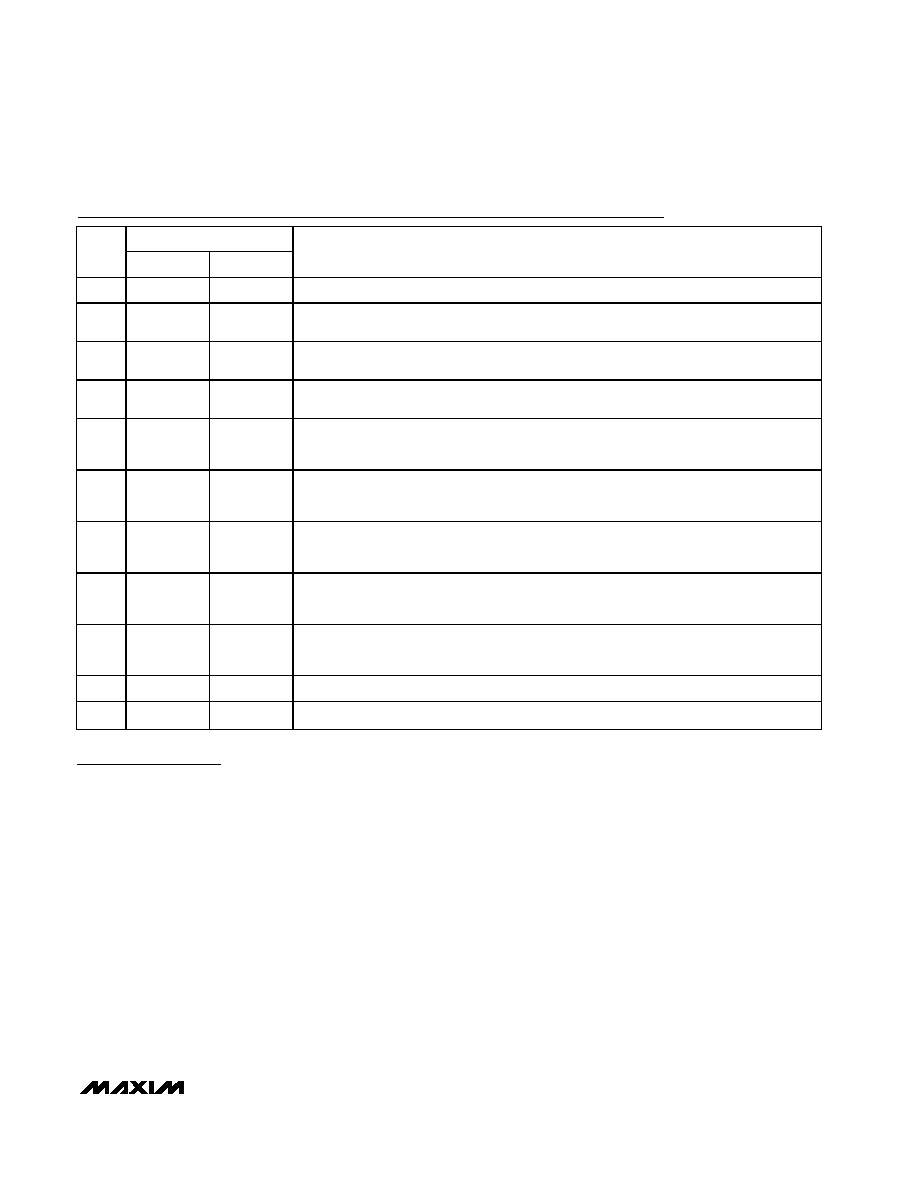- 您現(xiàn)在的位置:買賣IC網(wǎng) > PDF目錄180477 > MAX1744EUB+T (MAXIM INTEGRATED PRODUCTS INC) High-Voltage, Step-Down DC-DC Controller in µMAX PDF資料下載
參數(shù)資料
| 型號: | MAX1744EUB+T |
| 廠商: | MAXIM INTEGRATED PRODUCTS INC |
| 元件分類: | 穩(wěn)壓器 |
| 英文描述: | High-Voltage, Step-Down DC-DC Controller in µMAX |
| 中文描述: | SWITCHING CONTROLLER, 330 kHz SWITCHING FREQ-MAX, PDSO10 |
| 封裝: | MICRO MAX PACKAGE-10 |
| 文件頁數(shù): | 12/14頁 |
| 文件大小: | 256K |
| 代理商: | MAX1744EUB+T |

MAX1744/MAX1745
High-Voltage, Step-Down DC-DC
Controller in MAX
_______________________________________________________________________________________
7
Detailed Description
The MAX1744/MAX1745 are high-voltage step-down
DC-DC converter controllers. These devices offer high
efficiency over a wide range of input/output voltages
and currents, making them optimal for use in applica-
tions such as telecom, automotive, and industrial con-
trol. Using an external P-channel MOSFET and
current-sense resistor allows design flexibility and
improved efficiency. The MAX1744/MAX1745 automati-
cally switch from PWM operation at medium and heavy
loads to pulse-skipping operation at light loads to
improve light-load efficiency. The low 90A quiescent
current further optimizes these parts for applications
where low input current is critical. Operation to 100%
duty cycle allows the lowest possible dropout voltage,
which allows a wider input voltage variation. The small
size, high switching frequency, and low parts count
minimize the required circuit board area and compo-
nent cost. Figure 1 shows the MAX1744 typical applica-
tion circuit.
Operating Modes
When delivering low output currents, the MAX1744/
MAX1745 operate in discontinuous-conduction mode.
Current through the inductor starts at zero, rises as
high as the current limit, then ramps down to zero dur-
ing each cycle (Figure 3). The switch waveform exhibits
ringing, which occurs at the resonant frequency of the
inductor and stray capacitance, due to residual energy
trapped in the core when the commutation diode (D1 in
Figure 1) turns off.
When delivering medium-to-high output currents, the
MAX1744/MAX1745 operate in PWM continuous-con-
duction mode (Figure 4). In this mode, current always
flows through the inductor and never ramps to zero.
The control circuit adjusts the switch duty cycle to
maintain regulation without exceeding the peak switch-
ing current set by the current-sense resistor.
Pin Description
PIN NAME
PIN
MAX1744
MAX1745
FUNCTION
1
GND
Ground
2VL
VL
5V Linear Regulator Output. VL provides power to the internal circuitry and can supply up
to 1mA to an external load. Bypass VL to GND with 4.7F or greater capacitor.
3
REF
1.25V Reference Output. REF can supply up to 100A to an external load. Bypass REF to
GND with a 0.1F or greater ceramic capacitor.
43/5
—
3.3V or 5V Selection. Connect 3/5 to GND to set the output voltage to 3.3V. Connect 3/5 to
VL to set the output voltage to 5V.
4
—
FB
Feedback Input for Adjustable Output Operation. Connect to an external voltage-divider
between the output and FB to set the output voltage. The regulation voltage threshold is
1.25V.
5
OUT
Sense Input for Fixed 5V or 3.3V Output Operation (MAX1744) and Negative Current-Sense
Input (MAX1744/5). OUT is connected to an internal voltage-divider (MAX1744). OUT does
not supply current.
6CS
CS
Current-Sense Input. Connect the current-sense resistor between CS and OUT. External
MOSFET is turned off when the voltage across the resistor is equal to or greater than the
current limit trip level (100mV).
7
SHDN
Active-Low Shutdown Input. Connect
SHDN to IN for normal operation. Drive SHDN to low
to shut the part off. In shutdown mode, the reference, output, external MOSFET, and
internal regulators are turned off.
8VH
VH
High-Side Linear Regulator Output. VH provides a regulated output voltage that is 5V below
IN. The external P-channel MOSFET gate is driven between IN and VH. Bypass VH to IN
with a 4.7F or greater capacitor (see the Capacitor Selection section).
9
EXT
Gate Drive for External P-Channel MOSFET. EXT swings between IN and VH.
10
IN
Positive Supply Input. Bypass IN to GND with a 0.47F or greater ceramic capacitor.
相關(guān)PDF資料 |
PDF描述 |
|---|---|
| MAX1745AUB+T | High-Voltage, Step-Down DC-DC Controller in µMAX |
| MAX1745EUB+T | High-Voltage, Step-Down DC-DC Controller in µMAX |
| MAX1744AUB+ | High-Voltage, Step-Down DC-DC Controller in µMAX |
| MAX1744EUB+ | High-Voltage, Step-Down DC-DC Controller in µMAX |
| MAX1745AUB+ | High-Voltage, Step-Down DC-DC Controller in µMAX |
相關(guān)代理商/技術(shù)參數(shù) |
參數(shù)描述 |
|---|---|
| MAX1744EVKIT | 功能描述:DC/DC 開關(guān)控制器 Evaluation Kit for the MAX1744 MAX1745 RoHS:否 制造商:Texas Instruments 輸入電壓:6 V to 100 V 開關(guān)頻率: 輸出電壓:1.215 V to 80 V 輸出電流:3.5 A 輸出端數(shù)量:1 最大工作溫度:+ 125 C 安裝風(fēng)格: 封裝 / 箱體:CPAK |
| MAX1745AUB | 功能描述:DC/DC 開關(guān)控制器 RoHS:否 制造商:Texas Instruments 輸入電壓:6 V to 100 V 開關(guān)頻率: 輸出電壓:1.215 V to 80 V 輸出電流:3.5 A 輸出端數(shù)量:1 最大工作溫度:+ 125 C 安裝風(fēng)格: 封裝 / 箱體:CPAK |
| MAX1745AUB+ | 功能描述:DC/DC 開關(guān)控制器 Step-Down DC/DC Controller RoHS:否 制造商:Texas Instruments 輸入電壓:6 V to 100 V 開關(guān)頻率: 輸出電壓:1.215 V to 80 V 輸出電流:3.5 A 輸出端數(shù)量:1 最大工作溫度:+ 125 C 安裝風(fēng)格: 封裝 / 箱體:CPAK |
| MAX1745AUB+T | 功能描述:DC/DC 開關(guān)控制器 Step-Down DC/DC Controller RoHS:否 制造商:Texas Instruments 輸入電壓:6 V to 100 V 開關(guān)頻率: 輸出電壓:1.215 V to 80 V 輸出電流:3.5 A 輸出端數(shù)量:1 最大工作溫度:+ 125 C 安裝風(fēng)格: 封裝 / 箱體:CPAK |
| MAX1745AUB-T | 功能描述:DC/DC 開關(guān)控制器 RoHS:否 制造商:Texas Instruments 輸入電壓:6 V to 100 V 開關(guān)頻率: 輸出電壓:1.215 V to 80 V 輸出電流:3.5 A 輸出端數(shù)量:1 最大工作溫度:+ 125 C 安裝風(fēng)格: 封裝 / 箱體:CPAK |
發(fā)布緊急采購,3分鐘左右您將得到回復(fù)。